Wildlife spotting right out the window this afternoon!

What have you seen out the window this week?

Wildlife spotting right out the window this afternoon!

What have you seen out the window this week?
There may be a blanket of snow on the ground, but now is a great time to start thinking about the invasive species in your backyard. Our Ecological Management Coordinator, Tia Pinney, has some great tips for getting started:

Garlic mustard
Have you already taken on an invasive species management project? Share your tips here!
Need help getting started? Here’s a list of resources recommended by Tia.
On January 8, Mass Audubon turned our advocacy lens to Bill H.2864, an act to designate Drumlin Farm’s resident groundhog “Ms. G” as the State Groundhog of Massachusetts. Sponsored by Representative Alice Peisch of Wellesley in an effort to encourage students to study meteorology and other sciences, Ms. G’s campaign has been spearheaded by Drumlin Farm with strong support from former TV meteorologist Mish Michaels. Students at the Hunnewell Elementary School in Wellesley, where Mish’s daughter is a member of the first grade class, have led the effort behind the bill while learning about the legislative process.

Wednesday’s official hearing was held at the Wellesley Free Library as a special session of the Joint Committee on State Administration and Regulatory Oversight. The first grade students marched around the room waving posters and sporting groundhog masks, while shouts of “Ms. G ROCKS!” filled the air as they awaited the arrival of their guests from the statehouse. Drumlin Farm’s Visitor Education Coordinator, Renata Pomponi, gathered the students together to talk about Ms. G and answer the students’ questions. “Will Ms. G be here today?” “What is Ms. G’s favorite food?” “Does she ever wake up in the winter?”
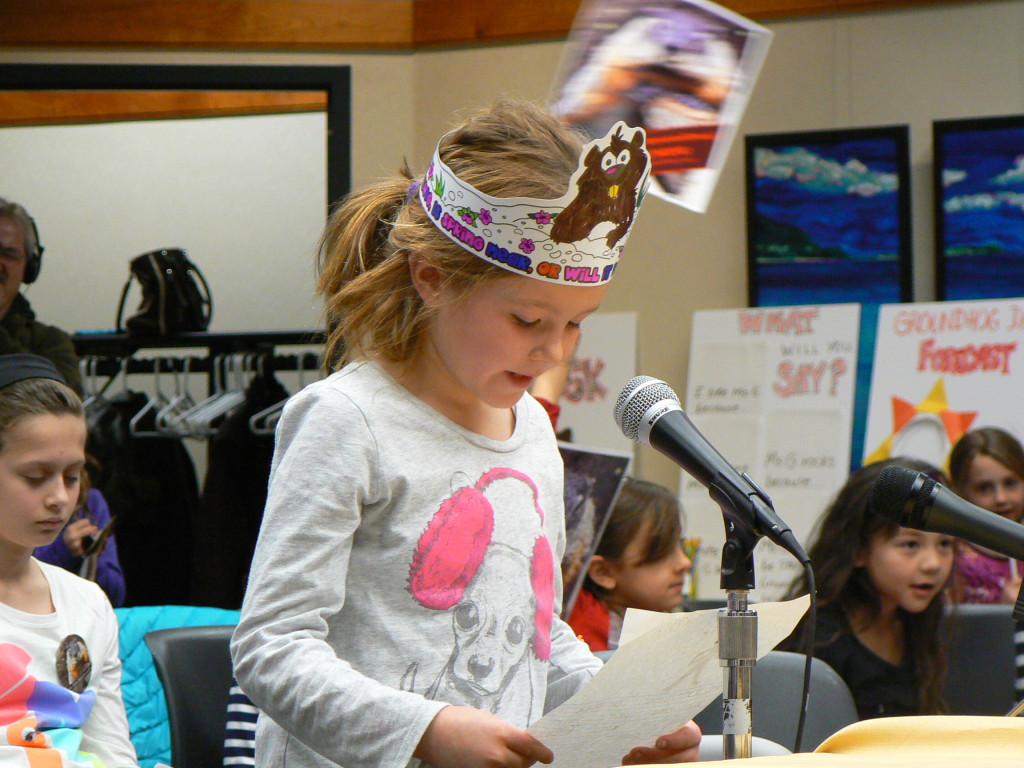
House Committee Chairman Peter Kocot led the hearing, with Rep. Peisch and Rep. Ann-Margaret Ferrante. Rep. Peisch called each student to the microphone, where they delivered their testimony with wisdom and enthusiasm. The most common testimonies were, “I support Ms. G because she is cute and everyone will like her” and, “last year, Punxsutawney Phil’s prediction was wrong, but Ms. G was right.” One student took on the important role of advocate as he presented the written testimony of several missing classmates.

Once the students had completed their testimony, several adults testified on Ms. G’s behalf as well, including Renata Pomponi and Drumlin Farm Sanctuary Committee member Joe Schick, who spoke on the important role that Drumlin Farm and our wildlife have in promoting environmental education and conservation in Massachusetts. Mish Michaels focused her testimony on the important lessons students will learn as a result of the passage of this bill. As the hearing came to a close, Chairman Kocot asked all in favor of the bill to raise their hands—the support was unanimous. Though he could not make any promises, Chairman Kocot remarked that he thought things would turn out well for Ms. G on Beacon Hill.
Check out the television coverage of this hearing for Ms. G’s bill on WBZ, and don’t forget to join us at Drumlin Farm February 2 to see Ms. G make her prediction!
The weather may be cold and overcast, but Drumlin Farm’s solar arrays are still hard at work producing renewable energy.
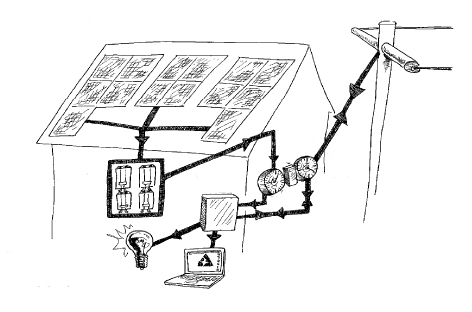
Even on an overcast day, radiant energy from the sun reaches the surface of the earth and is absorbed by solar panels to produce energy. Though not as much energy is produced in overcast weather as there would be in full sun, the solar panels still play an active role in off-setting the need for carbon-based fuels. During the gray winter months of 2013, Drumlin Farm’s Nature Center array produced over 1,700 kilowatt hours of energy, while the Sheep and Goat Barn array produced almost 1,800 kilowatt hours.
Cold weather helps the solar panels retain the energy produced. Less energy is lost as heat, so more energy is able to be used for power. Hot weather, though usually associated with more frequent sunny days and more hours of sunlight per day, decreases the efficiency of solar power production resulting in less energy created per hour of sunlight.
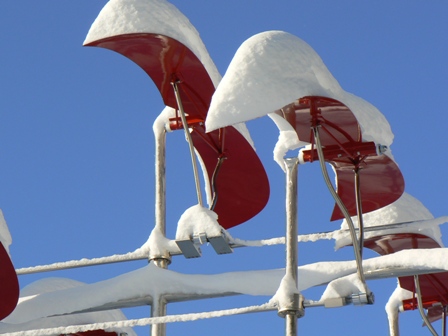
Interested in learning more about Drumlin Farm’s solar energy or other “green” initiatives? Visit our website to track our solar energy production and use, or see what other ways Drumlin Farm has been going green. You may even find some inspiration to make your life greener, too!
After all this snow and cold, what are all the Drumlin Farm animals up to? We took a stroll around the farmyard to find out!
Wild turkeys roam the wooded area in front of the Nature Center searching for food. Looks like they found a good spot!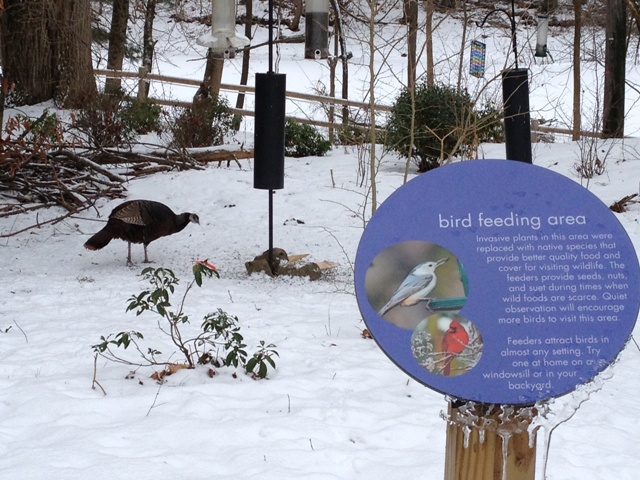 The sheep at the Crossroads Barn are spread across the hill below the Nature Center.
The sheep at the Crossroads Barn are spread across the hill below the Nature Center.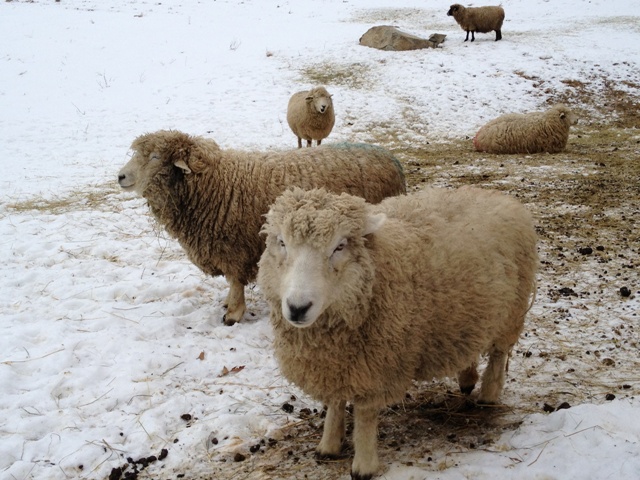 On Bird Hill, we’re missing the vultures, but these red-tailed hawks are as alert as ever.
On Bird Hill, we’re missing the vultures, but these red-tailed hawks are as alert as ever.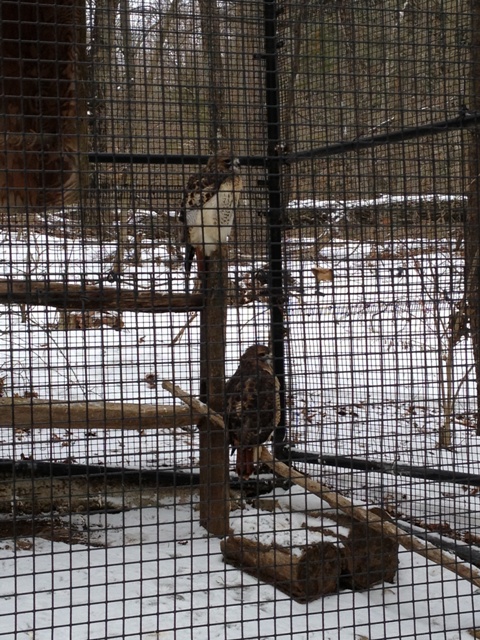 The fisher enjoys an afternoon frolic.
The fisher enjoys an afternoon frolic. Down at the garden, the plants are insulated by a blanket of snow.
Down at the garden, the plants are insulated by a blanket of snow. This farmyard sheep is relaxing with a snowy view of the Red Barn.
This farmyard sheep is relaxing with a snowy view of the Red Barn. Even the cows are taking advantage of the sunshine!
Even the cows are taking advantage of the sunshine! Looks like the animals are basking in the glories of winter. We hope you’ll join us for some winter activities, too!
Looks like the animals are basking in the glories of winter. We hope you’ll join us for some winter activities, too!
If you’ve recently been to Bird Hill, you may have noticed that the turkey vulture and black vulture are missing from their enclosures. Where did they go?
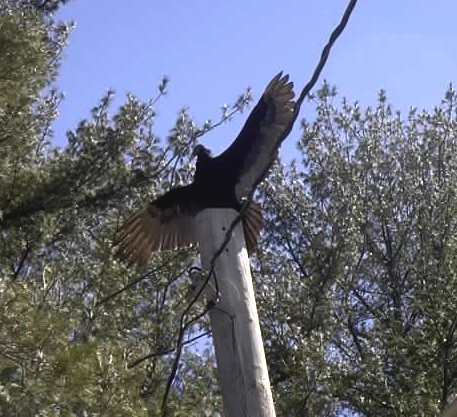
Turkey vultures are a migratory species. They breed throughout the United States and parts of Canada for the summer, then migrate to the Southeast, Central America, or South America for the winter. They are known to have nested in Massachusetts at least as early as 1945.
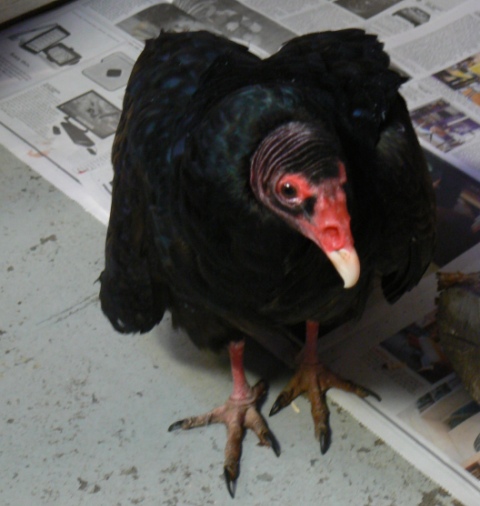
Black vultures are not typically associated with Massachusetts, rather they are historically found in the warmer climes of Central and South America. Since the 1970s, black vulture sightings in Massachusetts have increased significantly, and according to the recent Breeding Bird Atlas released by Mass Audubon, black vultures could be breeding in the southwestern area of the state. Black vultures are short-term migrators; they avoid severe weather, but return quickly once conditions improve.
Drumlin Farm’s vultures were brought indoors to the Wildlife Care Center, which is not open for general visitation, for the winter. Their indoor enclosures provide extra warmth with heat lamps to make sure the vultures are comfortable. They will return to their outdoor enclosures in the spring as the snow melts and temperatures become more tolerable.
On November 18th, Drumlin Farm welcomed the newest farmyard addition- a bull calf! Our farm staff arrived that morning to find him in the Red Barn with two of our other cows, Jane, a five-year old American Lineback cow, and a one-year old Brown Swiss X Devon steer. The calf is now in the sheep and goat barn, where staff are diligently caring for him while he adjusts to his surroundings before he moves back with the larger cow herd. If you see him and he is close enough, give him a gentle pat on the back!
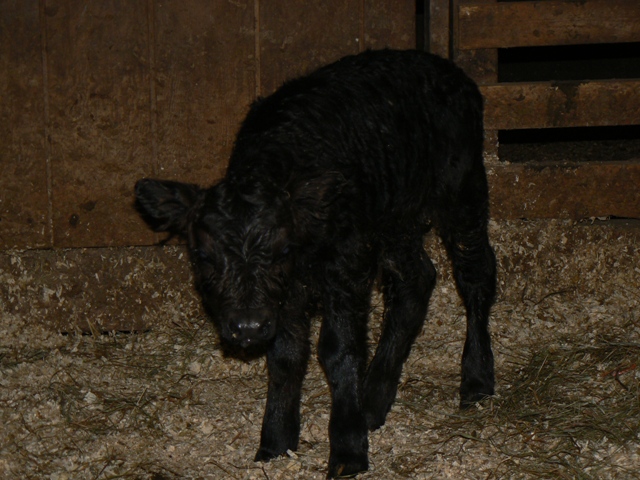 Our calf is a purebred Dexter, which is a breed known for its calm disposition and utility for both dairy and beef. Dexters are a Heritage breed, which means they have a long history in the United States, but are endangered due to recent farming practices. The birth of this calf is a proud moment for our conservation efforts!
Our calf is a purebred Dexter, which is a breed known for its calm disposition and utility for both dairy and beef. Dexters are a Heritage breed, which means they have a long history in the United States, but are endangered due to recent farming practices. The birth of this calf is a proud moment for our conservation efforts!
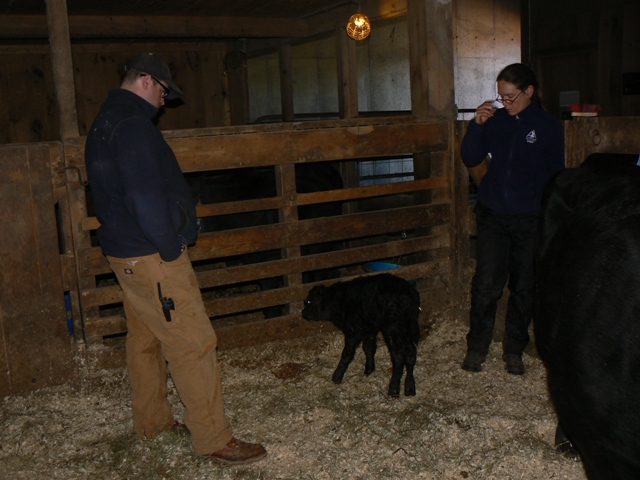 Come by to help us welcome our calf, or join us for programs like Winter Farm Family or Old MacDrumlin’s Farm to encounter the calf, the other cows, and the rest of our animals all winter long with fun activities!
Come by to help us welcome our calf, or join us for programs like Winter Farm Family or Old MacDrumlin’s Farm to encounter the calf, the other cows, and the rest of our animals all winter long with fun activities!
The favorite part of the workday for any Drumlin Farm educator is without a doubt being out in the fields, forests, and wetlands of our sanctuary, working with students and seeing them learn through deep engagement and discovery with the natural world. But if we have to be indoors, then it’s hard to beat the learning and discovery we ourselves experienced at the annual Massachusetts STEM Summit.
A joint effort of the Governor’s STEM Advisory Council, Mass Business Roundtable, and the UMass Donahue Institute, and sponsored in part this year by Mass Audubon, the STEM Summit brings together educators from across the state for a day of presentations, workshops, and sharing around the four educational components known as “STEM” – science, technology, engineering, and math. The 10th annual Summit, held at Gillette Stadium in Foxboro, was attended by nearly 1,200 educators including classroom teachers, educational firms and organizations, and community-based educators like the eight attendees who participated from Mass Audubon.
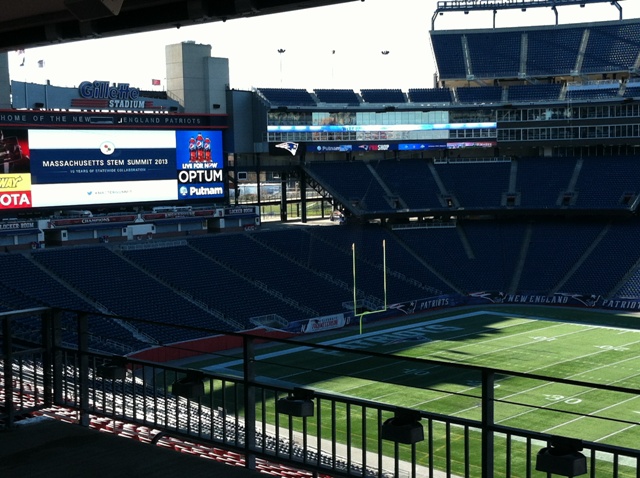 After an opening charge from Governor Deval Patrick, which unveiled Massachusetts STEM Plan 2.0, we spent the day buzzing about the complex, turning the box seats around the Patriots playing field into working laboratories for learning the latest philosophies, techniques, and tools for engaging students in STEM learning.
After an opening charge from Governor Deval Patrick, which unveiled Massachusetts STEM Plan 2.0, we spent the day buzzing about the complex, turning the box seats around the Patriots playing field into working laboratories for learning the latest philosophies, techniques, and tools for engaging students in STEM learning.
In one workshop, I explored workshops on methods ranging from project-based learning modules developed by the Boston Museum of Science, to digital gaming innovations from researchers at MIT’s Media Lab. One highlight of the workshops was working with two classroom teachers to build and test earthquake proof structures made from simple materials like paper, straws, and pipe cleaners. Meanwhile, Drumlin Farm Education Manager Kris Scopinich was learning about the newly drafted Massachusetts Science, Technology, and Engineering standards, and working with educators on how they will affect both in-school and out-of-school programming for PreK-12 students and teachers.
 During breaks, we wandered the exhibit halls, finding inspiration from the many nonprofit organizations, there to share their mission and opportunities, including Mass Audubon. Even the lunch-time presentation provided new ideas and inspiration, as we heard two young engineers share their passion and entrepreneurship in their journey to create a line of personally-piloted flying cars through their company Terrafugia.
During breaks, we wandered the exhibit halls, finding inspiration from the many nonprofit organizations, there to share their mission and opportunities, including Mass Audubon. Even the lunch-time presentation provided new ideas and inspiration, as we heard two young engineers share their passion and entrepreneurship in their journey to create a line of personally-piloted flying cars through their company Terrafugia.
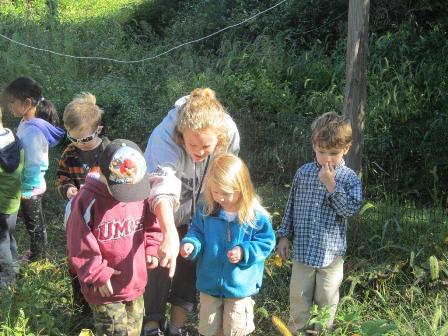 So if Mass Audubon is all about protecting the nature of Massachusetts, why did we devote a whole day inside to the STEM Summit? At the heart of how we approach our mission is finding ways to bring people closer to their environment through a process of science-based discovery. Over time, we have found innovative ways to incorporate math, engineering, and technology into our nature-based programming as well. Finding new ways to excite and engage our students in science will lead them to a deeper appreciation of the natural world, and subsequently a desire to protect it for future generations. At the same time, discovering ways to access nature through exciting new technologies and teaching tools helps us plug into kids and learning opportunities that we, and they, might not have found through more traditional methods. As we ourselves grow as educators through dynamic experiences such as an immersive day at the STEM Summit, we are able to bring new energy and ideas to our students back at Drumlin Farm, creating our own STEM revolution here in the fields, forests, and wetlands.
So if Mass Audubon is all about protecting the nature of Massachusetts, why did we devote a whole day inside to the STEM Summit? At the heart of how we approach our mission is finding ways to bring people closer to their environment through a process of science-based discovery. Over time, we have found innovative ways to incorporate math, engineering, and technology into our nature-based programming as well. Finding new ways to excite and engage our students in science will lead them to a deeper appreciation of the natural world, and subsequently a desire to protect it for future generations. At the same time, discovering ways to access nature through exciting new technologies and teaching tools helps us plug into kids and learning opportunities that we, and they, might not have found through more traditional methods. As we ourselves grow as educators through dynamic experiences such as an immersive day at the STEM Summit, we are able to bring new energy and ideas to our students back at Drumlin Farm, creating our own STEM revolution here in the fields, forests, and wetlands.
—Renata Pomponi is the Visitor Education Coordinator at Drumlin Farm.
With the trees finally bare and the midst of winter migrations, November is a great time for birding. Last Saturday, the Drumlin Farm Saturday bird walk ventured to Arlington Reservoir. The birders found 7 different species of ducks, including gadwall, American wigeon, northern shoveler, green-winged teal, hooded merganser, ruddy duck and of course, mallards. This American wigeon is a male in breeding plumage, distinguishable by the green eye stripe, white forehead, and little white hip patch.
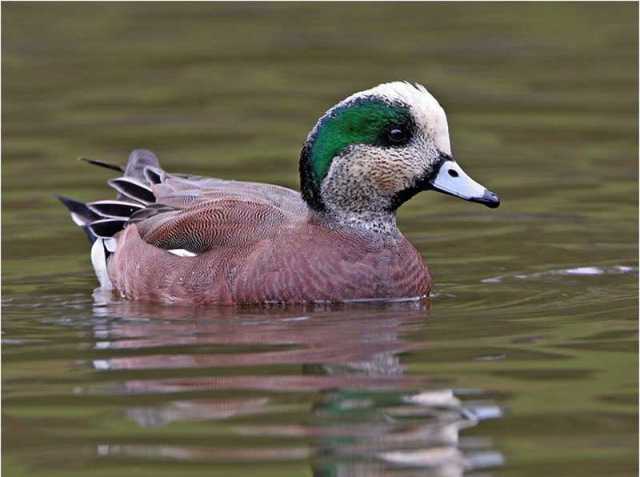 Another exciting find were American Tree Sparrows! American Tree Sparrows spend the summers breeding in Northern Canada, then migrate to the States for the winter. Once the snow starts to fall, these birds will drink up to 30% of the weight in water by eating the snow. Last week was the first sighting of American Tree Sparrows for everyone in the group this year.
Another exciting find were American Tree Sparrows! American Tree Sparrows spend the summers breeding in Northern Canada, then migrate to the States for the winter. Once the snow starts to fall, these birds will drink up to 30% of the weight in water by eating the snow. Last week was the first sighting of American Tree Sparrows for everyone in the group this year.
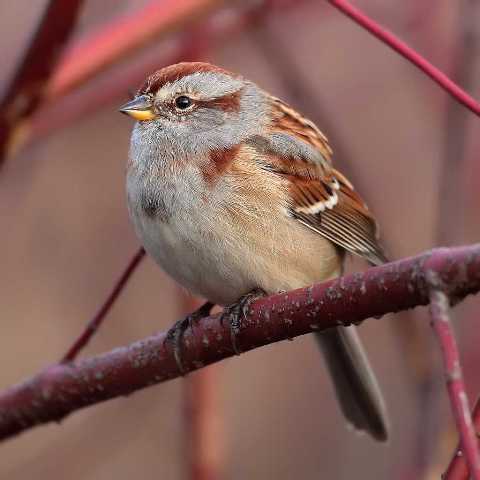 Drumlin Farm’s nature walks always provide great opportunities to explore the outdoors. Bird focused walks are offered in the spring and fall on Thursdays and Saturdays and naturalist walks are offered once a month year round. All are welcome and encouraged to join the walk and share in the discovery of nature. No registration is required but if you’d like to join, email Jennifer Riley for more information. Or if you’re looking for a more rigorous bird excursion, check our program guide for local and out-of–state birding trips led by Mass Audubon experts!
Drumlin Farm’s nature walks always provide great opportunities to explore the outdoors. Bird focused walks are offered in the spring and fall on Thursdays and Saturdays and naturalist walks are offered once a month year round. All are welcome and encouraged to join the walk and share in the discovery of nature. No registration is required but if you’d like to join, email Jennifer Riley for more information. Or if you’re looking for a more rigorous bird excursion, check our program guide for local and out-of–state birding trips led by Mass Audubon experts!
Be sure to keep us posted on your exciting wildlife sightings, too! Get in touch on facebook or leave us a comment here!
As a chill sets into the air, we’ve closed our farmstand for the season, but we still look forward to sharing our sustainable harvest with you. We’ve been busy storing the last of our fall crops for our winter Community Supported Agriculture (CSA) program. Lots of warmth and just enough rain made for huge harvests of flavorful tomatoes, eggplant, peppers, corn, and melons this summer, and those same conditions favored our root vegetables later in the season. We tested some new crops, and are thrilled with the yield.
 We added three new varieties of storage potatoes to our crop plan this year: Kerr’s Pink (beige pink skin, light yellow flesh), Desiree (rose red skin, yellow flesh) and Strawberry Paw (bright red skin, white flesh). Combined with returning varieties such as the Purple Viking, Kennebec, and Adirondack Red potatoes, our rainbow harvest of storage potatoes totals over four thousand pounds!
We added three new varieties of storage potatoes to our crop plan this year: Kerr’s Pink (beige pink skin, light yellow flesh), Desiree (rose red skin, yellow flesh) and Strawberry Paw (bright red skin, white flesh). Combined with returning varieties such as the Purple Viking, Kennebec, and Adirondack Red potatoes, our rainbow harvest of storage potatoes totals over four thousand pounds!
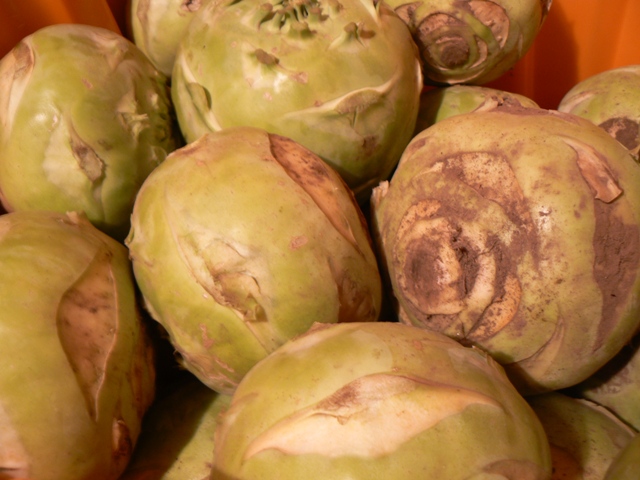 The sweet and tender Gilfeather turnip is also a new crop for us in 2013. It’s called a turnip but is actually a rutabaga with creamy white flesh instead of the yellow flesh of a traditional rutabaga. Did you know that rutabagas are the result of crossing turnips with cabbage?
The sweet and tender Gilfeather turnip is also a new crop for us in 2013. It’s called a turnip but is actually a rutabaga with creamy white flesh instead of the yellow flesh of a traditional rutabaga. Did you know that rutabagas are the result of crossing turnips with cabbage?
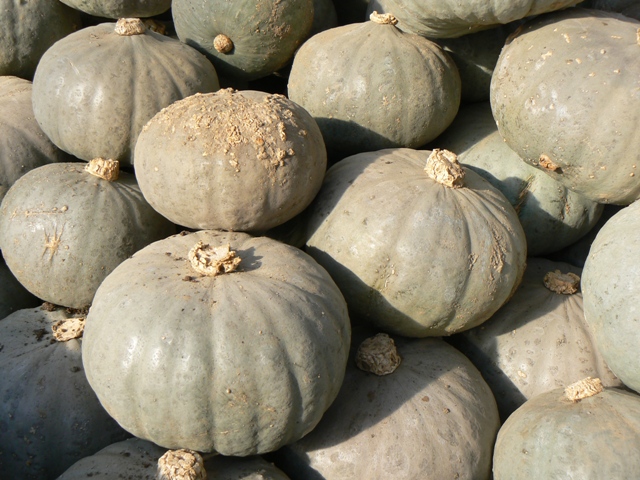 Hearty squash are a staple of the season, and we are excited to add Winter Sweet squash to our mix. It’s shaped like a turban with light blue skin and bright orange flesh, and is a delicious all-purpose variety. Of course we still grow and harvest the ever-popular butternut, as well as buttercup, acorn and delicata squash.
Hearty squash are a staple of the season, and we are excited to add Winter Sweet squash to our mix. It’s shaped like a turban with light blue skin and bright orange flesh, and is a delicious all-purpose variety. Of course we still grow and harvest the ever-popular butternut, as well as buttercup, acorn and delicata squash.
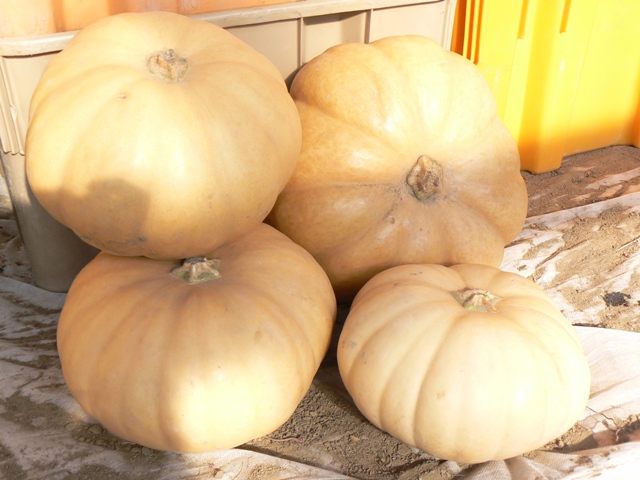 We also have a bumper crop of Long Island cheese baking pumpkins. These are excellent in pies and custards because of the large quantity of sweet flesh–no need to scrape away at several small sugar pumpkins in order to make your Thanksgiving treats.
We also have a bumper crop of Long Island cheese baking pumpkins. These are excellent in pies and custards because of the large quantity of sweet flesh–no need to scrape away at several small sugar pumpkins in order to make your Thanksgiving treats.
We’ve already harvested and stored over a thousand pounds of big, beautiful beets, and over two thousand pounds of Bolero storage carrots. Other late crops include watermelon radish, storage kohlrabi, parsnips, sweet potatoes, celeriac, onions, and garlic.
Over the next two weeks, we’ll continue harvesting some storage crops into our energy-efficient root cellar (just a small fan and cold night air keeps all those roots cool and fresh!) and we’ll keep some field greens under cover to add variety to the first two CSA distributions.
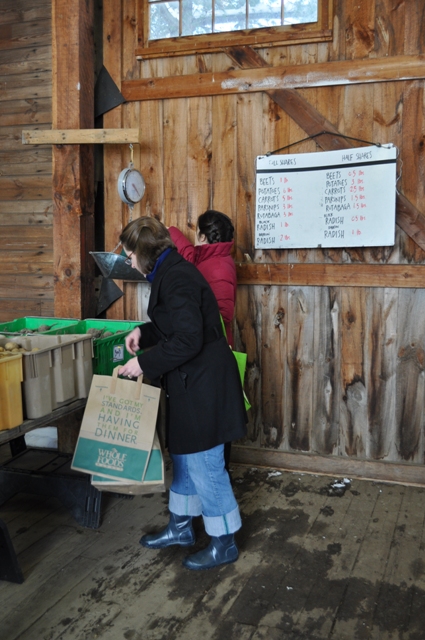 From November through February, CSA members will enjoy eight distributions (link to the registration listing) of the best of our harvest, while supporting locally and responsibly grown produce. We still have shares available if you’re looking to eat locally this winter. It’s a great way to try new foods, and we think you’ll enjoy sharing the diverse harvest with your friends and family.
From November through February, CSA members will enjoy eight distributions (link to the registration listing) of the best of our harvest, while supporting locally and responsibly grown produce. We still have shares available if you’re looking to eat locally this winter. It’s a great way to try new foods, and we think you’ll enjoy sharing the diverse harvest with your friends and family.